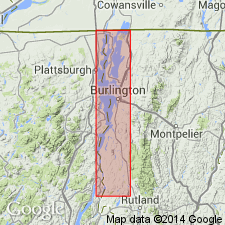
- Usage in publication:
-
- Sawyer Bay Member
- Modifications:
-
- Named
- Dominant lithology:
-
- Limestone
- AAPG geologic province:
-
- New England province
- Adirondack uplift
Summary:
The Sawyer Bay is herein defined as a member of the Lowville Formation of the Black River Group. Occurs approximately in the middle of the Lowville throughout the Champlain Valley and represents a significant deepening event. Lower part of the Lowville was deposited in a shallow lagoonal environment, while the Sawyer Bay was deposited in a subtidal normal marine environment. Deposition probably the result of high angle block faulting in the Champlain basin. Member is very dark gray to black micrite to sparite in composition with irregular "lumpy" bedding, wavy lamination, cross-lamination, and ripple marks. Irregularly shaped, scattered chert nodules are concentrated in specific horizons. Contains a few large and small brachiopods, trilobite fragments and some fossil hash. Unit is approximately 6 ft thick at Sawyer Point, South Hero Island, northwestern VT; thins to 2 ft at Arnold Bay, and becomes an indistinct rubbly unit at Crown Point, northeastern NY. Age is Middle Ordovician (Blackriveran).
Source: GNU records (USGS DDS-6; Reston GNULEX).
For more information, please contact Nancy Stamm, Geologic Names Committee Secretary.
Asterisk (*) indicates published by U.S. Geological Survey authors.
"No current usage" (†) implies that a name has been abandoned or has fallen into disuse. Former usage and, if known, replacement name given in parentheses ( ).
Slash (/) indicates name conflicts with nomenclatural guidelines (CSN, 1933; ACSN, 1961, 1970; NACSN, 1983, 2005, 2021). May be explained within brackets ([ ]).

